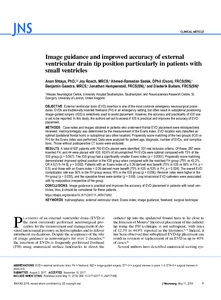Shtaya, A; Roach, J; Sadek, A-R; Gaastra, B; Hempenstall, J; Bulters, D
(2019)
Image guidance and improved accuracy of external ventricular drain tip position particularly in patients with small ventricles.
J Neurosurg, 130 (4).
pp. 1268-1273.
ISSN 1933-0693
https://doi.org/10.3171/2017.11.JNS171892
SGUL Authors: Shtaya, Anan BY
![[img]](https://openaccess.sgul.ac.uk/109848/1.hassmallThumbnailVersion/2017.11.jns171892.pdf)  Preview |
|
PDF
Published Version
Available under License ["licenses_description_publisher" not defined].
Download (2MB)
| Preview
|
Abstract
OBJECTIVE External ventricular drain (EVD) insertion is one of the most common emergency neurosurgical procedures. EVDs are traditionally inserted freehand (FH) in an emergency setting, but often result in suboptimal positioning. Image-guided surgery (IGS) is selectively used to assist placement. However, the accuracy and practicality of IGS use is yet to be reported. In this study, the authors set out to assess if IGS is practical and improves the accuracy of EVD placement. METHODS Case notes and images obtained in patients who underwent frontal EVD placement were retrospectively reviewed. Ventriculomegaly was determined by the measurement of the Evans index. EVD location was classified as optimal (ipsilateral frontal horn) or suboptimal (any other location). Propensity score matching of the two groups (IGS vs FH) for the Evans index was performed. Data were analyzed for patient age, diagnosis, number of EVDs, and complications. Those without postoperative CT scans were excluded. RESULTS A total of 607 patients with 760 EVDs placed were identified; 331 met inclusion criteria. Of these, 287 were inserted FH, and 44 were placed with IGS; 60.6% of all unmatched FH EVDs were optimal compared with 75% of the IGS group (p = 0.067). The IGS group had a significantly smaller Evans index (p < 0.0001). Propensity score matching demonstrated improved optimal position in the IGS group when compared with the matched FH group (75% vs 43.2%, OR 4.6 [1.5-14.6]; p = 0.002). Patients with an Evans index of ≥ 0.36 derived less benefit (75% in IGS vs 66% in FH, p = 0.5), and those with an Evans index < 0.36 derived more benefit (75% in IGS vs 53% in FH, p = 0.024). The overall EVD complication rate was 36% in the FH group versus 18% in the IGS group (p = 0.056). Revision rates were higher in the FH group (p = 0.035), and the operative times were similar (p = 0.69). Long intracranial EVD catheters were associated with tip malposition irrespective of the group. CONCLUSIONS Image guidance is practical and improves the accuracy of EVD placement in patients with small ventricles; thus, it should be considered for these patients.
| Item Type: |
Article
|
| Additional Information: |
© AANS 2018, except where prohibited by US copyright law
Published online May 11, 2018; DOI: 10.3171/2017.11.JNS171892 |
| Keywords: |
EVD = external ventricular drain, Evans index, FH = freehand, IGS = image-guided surgery, ST1–3 = surgical trainees in years 1–3, ST4–8 = surgical trainees in years 4–8, external ventricular drain, freehand, hydrocephalus, image guidance, surgical technique, Neurology & Neurosurgery, 1103 Clinical Sciences, 1109 Neurosciences |
| SGUL Research Institute / Research Centre: |
Academic Structure > Molecular and Clinical Sciences Research Institute (MCS) |
| Journal or Publication Title: |
J Neurosurg |
| ISSN: |
1933-0693 |
| Language: |
eng |
| Dates: |
| Date | Event |
|---|
| April 2019 | Published | | 11 May 2018 | Published Online | | 10 November 2017 | Accepted |
|
| Publisher License: |
Publisher's own licence |
| PubMed ID: |
29749916 |
 |
Go to PubMed abstract |
| URI: |
https://openaccess.sgul.ac.uk/id/eprint/109848 |
| Publisher's version: |
https://doi.org/10.3171/2017.11.JNS171892 |
Statistics
Item downloaded times since 24 May 2018.
Actions (login required)
 |
Edit Item |



